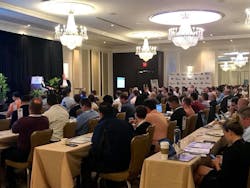Z-Wave Fall Summit focuses on the evolution of the smart home
Twice a year, the manufacturers, solutions providers, integrators and partners who all support the Z-Wave smart home standard gather together in the U.S. and Europe to collaborate, engage, discuss and learn about the year ahead and the momentum of IoT as a whole. Just a few weeks ago, representatives from over 75 smart home brands filled a room in a Philadelphia-area hotel to hear Google’s Katelyn Mason give a talk on the tech giant’s vision for the “intelligent home” of the future for the Z-Wave Fall Summit audience. Each participant – a mix of marketers, business development leaders, developers and engineers – joined the Z-Wave Alliance and Silicon Labs Z-Wave teams to map the future of the standard and its role in the market together.
The Z-Wave Summit kicked off with a series of talks and panels designed to help Z-Wave Alliance member companies and its partners think about the next opportunity around the smart home. Z-Wave continues to have one of the largest IoT ecosystems on the market today with over 2,400 certified devices and over 700 companies in the organization.
The event is split into two tracks – business/marketing and technical – each with content directed toward the different audiences. Attendees listened to and participated in a series of panels, fireside chats, and workshops led by industry leaders and peers on smart home and IoT. Each session focused on different topics, including smart home trends, go-to-market strategies, and evolving smart home technology like the implementation of AI from Alex Capecelatro, co-founder and CEO of Josh.ai. Ben Arnold, Senior Director, Innovation & Trends, at the Consumer Technology Association (CTA), presented early research findings that showed over a third of consumers plan to buy smart home gear this holiday season, and the go-to-market panel featuring Ring, Qolsys, PlumChoice, and CTA, discussed the new challenges in bringing devices to market as the smart home ecosystem grows and matures.
This year’s Z-Wave Summit tackled a few different key themes including insurance, artificial intelligence, IoT adoption trends, as well as data and privacy. To ensure robust discussions, Z-Wave leaders invited external partners including Google, Parks Associates, Wirecutter (NYT tech review site), Josh.ai, American Modern Insurance, PlumChoice and the Consumer Technology Association (CTA) to share their perspectives and expertise with Alliance member companies.
With the growth of smart home and buzz around the adoption of high-profile products like Google Home and Amazon Echo, insurance providers are looking at ways to incentivize their customers to adopt certain types of tech in their homes. To contribute to the discussion, Z-Wave invited American Modern Insurance to present a case study at the Summit on their year-long pilot in Alabama, Colorado and Ohio where they offered a program that provided smart home products in manufactured and owner-occupied homes coupled with an incentivized insurance package. After the presentation, the Z-Wave Alliance team brought several more voices on stage including smart home analyst Brad Russell of Parks Associates to host a panel discussion on smart home and insurance, exploring the complexities involved in providing smart home products to policy holders.
The Z-Wave Alliance also welcomed case study presentations from Evolve Controls on their success with smart home solutions for the hospitality industry as well as Felicite Moorman, CEO of Stratis/Bulogics to give attendees an overview of the MDU(multi-dwelling unit) opportunity. Moorman focused on how connected home is moving beyond individual residential deployments to multi-family dwellings and apartment complexes and what elements to consider based on their experience with past and current clients.
The Fall Summit boasted the highest number of participants to date, with the participation of new and important voices in the industry contributing to the conversation. It was clear to everyone in attendance that the global implications for IoT are enormous; and though we still refer to the space as the “smart home,” it is evolving well beyond the four walls of the single-family home to transform apartments, offices, hotels and cities.


